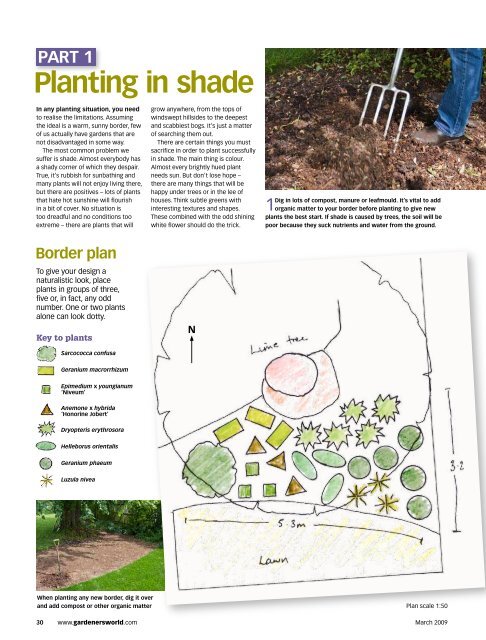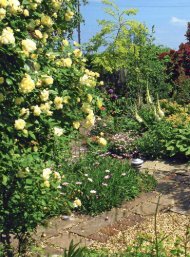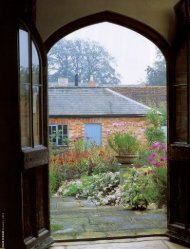Plant the perfect border with James Alexander-Sinclair's
Plant the perfect border with James Alexander-Sinclair's
Plant the perfect border with James Alexander-Sinclair's
- No tags were found...
Create successful ePaper yourself
Turn your PDF publications into a flip-book with our unique Google optimized e-Paper software.
gardens<br />
Part 1<br />
<strong>Plant</strong>ing in shade<br />
In any planting situation, you need<br />
to realise <strong>the</strong> limitations. Assuming<br />
<strong>the</strong> ideal is a warm, sunny <strong>border</strong>, few<br />
of us actually have gardens that are<br />
not disadvantaged in some way.<br />
The most common problem we<br />
suffer is shade. Almost everybody has<br />
a shady corner of which <strong>the</strong>y despair.<br />
True, it’s rubbish for sunbathing and<br />
many plants will not enjoy living <strong>the</strong>re,<br />
but <strong>the</strong>re are positives – lots of plants<br />
that hate hot sunshine will flourish<br />
in a bit of cover. No situation is<br />
too dreadful and no conditions too<br />
extreme – <strong>the</strong>re are plants that will<br />
grow anywhere, from <strong>the</strong> tops of<br />
windswept hillsides to <strong>the</strong> deepest<br />
and scabbiest bogs. It’s just a matter<br />
of searching <strong>the</strong>m out.<br />
There are certain things you must<br />
sacrifice in order to plant successfully<br />
in shade. The main thing is colour.<br />
Almost every brightly hued plant<br />
needs sun. But don’t lose hope –<br />
<strong>the</strong>re are many things that will be<br />
happy under trees or in <strong>the</strong> lee of<br />
houses. Think subtle greens <strong>with</strong><br />
interesting textures and shapes.<br />
These combined <strong>with</strong> <strong>the</strong> odd shining<br />
white flower should do <strong>the</strong> trick.<br />
Dig in lots of compost, manure or leafmould. It’s vital to add<br />
1 organic matter to your <strong>border</strong> before planting to give new<br />
plants <strong>the</strong> best start. If shade is caused by trees, <strong>the</strong> soil will be<br />
poor because <strong>the</strong>y suck nutrients and water from <strong>the</strong> ground.<br />
Divide geraniums to make more plants – a decent specimen can often be<br />
2 chopped in half. When buying plants, look for <strong>the</strong> biggest and healthiest.<br />
Not only will <strong>the</strong>y do better than <strong>the</strong> weaklings, but you can divide some plants<br />
straight away. And that has to be good – two plants for <strong>the</strong> price of one!<br />
Position plants according to your plan but don’t worry if it<br />
3 needs a bit of tweaking, it’s <strong>the</strong>re as a guide. If you only see<br />
<strong>the</strong> <strong>border</strong> from one side, group more plants in your sightline.<br />
Don’t plant too near large trees because of <strong>the</strong>ir shallow roots.<br />
Border plan<br />
To give your design a<br />
naturalistic look, place<br />
plants in groups of three,<br />
five or, in fact, any odd<br />
number. One or two plants<br />
alone can look dotty.<br />
Key to plants<br />
N<br />
Sarcococca confusa<br />
Geranium macrorrhizum<br />
Epimedium x youngianum<br />
‘Niveum’<br />
Anemone x hybrida<br />
‘Honorine Jobert’<br />
Get planting! Add a handful of bone meal, general-purpose or granular slowrelease<br />
fertiliser to each planting hole. For pot-bound plants, tease apart<br />
4<br />
any tightly entwined roots <strong>with</strong> your fingers. When all <strong>the</strong> plants are in <strong>the</strong><br />
ground, lay a mulch of organic matter to suppress weeds and retain moisture.<br />
Water in new plantings – you should always do this, even<br />
5 if it’s raining. In a bed like this it would be sensible to keep<br />
watering for <strong>the</strong> first season. The plants will tell you if <strong>the</strong>y are<br />
thirsty because <strong>the</strong>y’ll go all droopy and wan, so listen to <strong>the</strong>m.<br />
Dryopteris erythrosora<br />
Helleborus orientalis<br />
Geranium phaeum<br />
factfile<br />
Total cost of plants<br />
£117.90<br />
Luzula nivea<br />
When planting any new <strong>border</strong>, dig it over<br />
and add compost or o<strong>the</strong>r organic matter<br />
Plan scale 1:50<br />
photos: paul debois. illustration: james alexander-sinclair<br />
The plants will fill out once<br />
6 established to create a<br />
flourishing <strong>border</strong> <strong>with</strong> plenty<br />
of colour, shape and texture.<br />
Time to prepare<br />
ground Two hours<br />
Time to plant<br />
Two hours<br />
Time to full<br />
maturity<br />
Two years<br />
Location<br />
Problem shady<br />
areas, any soil types<br />
30 www.gardenersworld.com<br />
March 2009 March 2009 www.gardenersworld.com 31

















